Unlocking Success: Essential Skills and Responsibilities of a Curriculum Designer
Introduction
The role of a curriculum designer in education technology is vital too shaping the future of learning at universities, colleges, and schools. As educational institutions increasingly embrace digital learning, skilled curriculum designers are in high demand to create engaging, accessible, and impactful learning experiences. If you’re a job seeker considering a career in curriculum development, understanding the essential skills and core responsibilities of this role is your gateway to a rewarding profession. This thorough guide explores what it takes to excel as a curriculum designer in the field of education technology, empowering you to make informed career decisions and unlock your success.
What Is a Curriculum Designer in Education Technology?
A curriculum designer (sometimes referred to as an instructional designer or learning designer) is a professional responsible for planning, developing, and evaluating educational programs and learning materials. Within the education technology sector, curriculum designers leverage digital tools to create tailored, effective, and scalable content suitable for a variety of learners. They collaborate with educators, subject matter experts, and technical teams to ensure that curriculum not only aligns with academic objectives but also utilizes the latest instructional methodologies and digital innovations.
Key responsibilities of a Curriculum Designer
The role of a curriculum designer is dynamic and multifaceted.Here are the core responsibilities expected in most positions within universities, colleges, and schools:
- Curriculum Development: Designing comprehensive educational programs and course structures that align with institutional and accreditation standards.
- Instructional Material creation: producing engaging multimedia content, including online modules, e-learning courses, instructional videos, and interactive simulations.
- Needs Assessment: Analyzing learner needs and curriculum gaps to inform the development of targeted learning solutions.
- Collaboration: Working closely with faculty, subject experts, educational technologists, and administrators to gather input and ensure curriculum quality.
- Assessment Design: Developing quizzes,exams,assignments,and other assessment tools to measure student learning outcomes.
- Quality Assurance: Reviewing and revising instructional materials based on feedback, data analytics, and best practices in pedagogy.
- Technology Integration: Leveraging learning management systems (LMS), adaptive learning platforms, and other edtech tools to deliver content efficiently.
- Research & Professional Development: Keeping up-to-date with educational trends, applying evidence-based practices, and participating in ongoing professional growth activities.
Essential Skills Required for Success as a Curriculum Designer
To thrive in education technology and excel as a curriculum designer, you need a blend of technical, creative, and interpersonal skills. Here are the most sought-after skills by universities,colleges,and schools:
1. Instructional design Expertise
- Proficient in instructional design models such as ADDIE, SAM, or Backward Design
- Ability to craft clear learning objectives and align them with assessments
- Experience with Global Design for Learning (UDL) and differentiated instruction
2. Educational Technology Proficiency
- Familiarity with major Learning Management Systems (e.g., Canvas, Blackboard, Moodle)
- Skill in authoring tools such as Articulate Storyline, Adobe Captivate, or H5P
- Understanding of multimedia production, including video, audio, and interactive content
3. Communication & Collaboration
- Strong written and verbal communication skills for articulating complex concepts
- Teamwork abilities for collaborating with faculty and cross-functional teams
- Receptive to feedback and open to iterative design processes
4. Analytical thinking & Problem-Solving
- Ability to conduct curriculum needs assessments and interpret learning data
- Creative approach to resolving instructional challenges and improving learning outcomes
- Competence in project management and balancing multiple priorities
5. Commitment to Digital Accessibility & Inclusion
- Designing content that meets accessibility standards (e.g., WCAG)
- Awareness of diverse learner needs and inclusive teaching practices
Benefits of Becoming a Curriculum Designer in EdTech
A career as a curriculum designer in educational technology offers numerous professional and personal advantages:
- impactful Work: You directly contribute to enhancing educational quality and student outcomes.
- Career Growth: Growing demand for digital education creates diverse roles in higher education, K-12, and continuing education.
- Continuous Learning: Opportunities to expand your technological skills and pedagogical knowledge.
- Creative Flexibility: Freedom to innovate using multimedia, gamification, AR/VR, and emerging educational tools.
- Collaboration: Work in dynamic, interdisciplinary teams with educators, technologists, and administrators.
- Job Stability: Robust prospects in academic institutions and private educational companies alike.
Practical Tips to Secure a Curriculum Designer Position
If you’re aspiring to land a curriculum designer job in the education technology sector at universities, colleges, or schools, here are actionable tips:
- Build a Strong Portfolio: Showcase sample curriculum, e-learning modules, and digital projects that highlight your instructional design skills.
- Earn Relevant Qualifications: Consider degrees or certifications in instructional design, educational technology, or related fields.
- Develop Technical Savvy: Master widely used edtech tools and keep up-to-date with new software and digital trends in education.
- Network within the Field: Join professional associations, attend webinars, and participate in online communities focused on edtech and curriculum design.
- Highlight Soft Skills: Demonstrate your collaboration,communication,and project management abilities in your resume and interviews.
- Pursue Continuous Professional Development: Attend conferences, workshops, and online courses to refine your expertise and stay marketable.
How Curriculum Designers Shape Modern Education
Curriculum designers are at the cutting edge of educational transformation. They consult with faculty to redesign customary curricula for digital delivery, integrate best practices for online engagement, and ensure that programs are inclusive and accessible to all learners. Their expertise is essential for creating adaptive learning paths, enriching classrooms with technology, and preparing students for the demands of a digital world. Whether working in higher education, K-12, or corporate training, curriculum designers are pivotal in ushering in an era of future-ready learning.
Conclusion
The path to becoming a prosperous curriculum designer in education technology is paved with creativity, interdisciplinary knowledge, and a continuous passion for learning.By mastering essential skills and embracing your multifaceted responsibilities, you can play a crucial role in shaping transformative educational experiences at universities, colleges, and schools. If you’re considering this career, equip yourself with the necessary competencies and stay inspired by the knowledge that your work will make a lasting difference in the academic journeys of countless learners.

